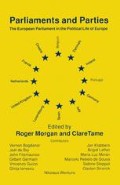Abstract
As Europe moves unsteadily forward from the Maastricht Treaty on European Union, in force since November 1993, towards the next Intergovernmental Conference, or IGC, scheduled for 1996, the future of the Union’s institutional structure is uncertain and highly controversial. This book considers one of the EU’s main institutions, the European Parliament (EP), from the specific angle of how it relates to Europe’s other institutions of representative democracy, the national parliaments of the EU’s member-states. One central aspect of the subject is the question of how far the EP, which has now been directly elected by Europe’s citizens in four successive elections between 1979 and 1994, can lay any claim to a greater legitimacy as the democratic controller of the EU’s policies than the national parliaments, whose claim to control their respective governments goes back in some cases for centuries.
Access this chapter
Tax calculation will be finalised at checkout
Purchases are for personal use only
Preview
Unable to display preview. Download preview PDF.
References
European Communities (1992) Treaty on European Union (Luxembourg Office for Official Publications).
European Parliament (1989) Symposium on the European Parliament in the Community System, November 1988 (‘National Parliaments’ Series No. 5) Luxembourg.
European Parliament (1993) 40th Anniversary, Proceedings of the Symposium of 18 September 1992 Luxembourg.
Ferdinand, H. (1981) ‘Die Beziehungen zwischen dem Europäischen Parlament und den nationalen Parlamenten’, Aus Politik und Zeitgeschichte, B7/81 (14 February 1981 ) 17–30.
Hix, S. (1995) ‘The European Party Federations: From Transnational Party Cooperation to Nascent European Parties’, in J. Gaffney, Ed., Political Parties and the European Union ( London: Routledge ).
Laprat, G. (forthcoming) ‘Parliamentary scrutiny of Community Legislation: an evolving idea’, in F. Laursen and S. Pappas (eds), The Changing Role of Parliaments in the European Union Maastricht, European Institute of Public Administration.
Lindberg, L. and Scheingold, S. (1970) Europe’s Would-be Polity ( Englewood Cliffs, NJ, Prentice-Hall).
Major, John (1994),‘Europe: a Future that Works’, speech at University of Leiden on 7 September 1994.
Morgan, R. (1979) ‘New Tasks for the European Parliament’, The World Today, Vol. 35, No. 11.
Shackleton, M. (forthcoming) ‘Interparliamentary Cooperation and the 1996 IGC’, in F. Laursen and S. Pappas, (eds) (see Laprat, above).
Editor information
Editors and Affiliations
Copyright information
© 1996 Macmillan Press Ltd
About this chapter
Cite this chapter
Morgan, R. (1996). Introduction. In: Morgan, R., Tame, C. (eds) Parliaments and Parties. Palgrave Macmillan, London. https://doi.org/10.1007/978-1-349-24387-7_1
Download citation
DOI: https://doi.org/10.1007/978-1-349-24387-7_1
Publisher Name: Palgrave Macmillan, London
Print ISBN: 978-1-349-24389-1
Online ISBN: 978-1-349-24387-7
eBook Packages: Palgrave Political & Intern. Studies CollectionPolitical Science and International Studies (R0)

